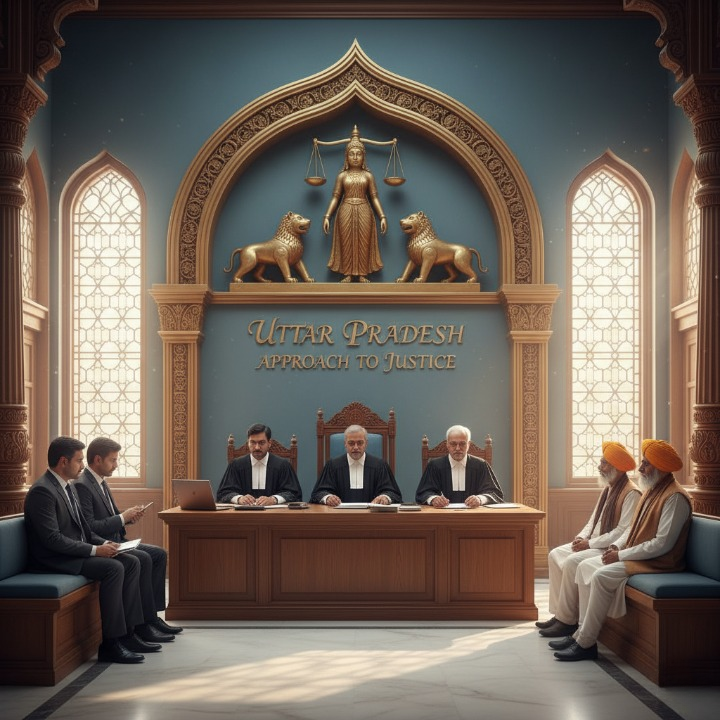
Uttar Pradesh’s Approach to Justice: Striking a Balance Between Tradition and Modernity
- admin
- October 2, 2025
- law & rights
- 0 Comments
Lucknow – Justice in Uttar Pradesh, a state deeply rooted in tradition yet striving for modern governance, presents a complex interplay of ancient philosophies and contemporary legal frameworks. As the state advances with reforms and programs aimed at ensuring equity, questions persist about whether justice is truly accessible to all or remains limited by systemic challenges and cultural barriers.
From the principles of dharma in ancient texts to Ambedkarite ideals of equality, Uttar Pradesh’s approach to justice reflects a long-standing commitment to fairness. However, high crime rates, caste inequities, and delays in judicial processes continue to test this resolve.
Key Metrics on Justice in Uttar Pradesh
- Case Pendency: Over 1.5 million cases are pending in courts across Uttar Pradesh, with average delays of 4.5 years (All India Judicial Services Report, 2023).
- Caste-Based Crimes: Dalits, comprising 22% of the state’s population, account for nearly 42% of all caste-related atrocities (National Commission for Scheduled Castes, 2023).
- Women’s Safety: Cases of crimes against women rose by 6.4% in 2022 despite initiatives like Mission Shakti(NCRB Report, 2023).
- Judicial Infrastructure: Uttar Pradesh operates over 73 district courts, but rural areas often lack adequate legal representation (State Judicial Overview, 2023).
Philosophical Foundations Guiding Justice
1. Dharma and Traditional Concepts
The concept of dharma, emphasizing moral duty and balance, continues to influence rural dispute resolution, often through panchayats.
- Strengths: Panchayats provide quick, community-driven resolutions to minor disputes.
- Concerns: These traditional systems often lack inclusivity, particularly for women and marginalized groups.
2. Ambedkarite Vision of Equality
Dr. B.R. Ambedkar’s philosophy underscores the importance of caste equity and social justice, forming the backbone of policies aimed at empowering marginalized communities.
- Impact: Reservation systems in education and employment aim to bridge historical inequalities.
- Challenges: Implementation gaps leave many Dalits without meaningful access to these opportunities.
3. Islamic Principles of Justice
With nearly 20% of the population identifying as Muslim, Islamic principles like Adl (justice) play a significant role in guiding community-led justice systems.
- Initiatives: Local organizations in cities like Aligarh and Bareilly focus on legal literacy and community rights advocacy.
Modern Legal Frameworks: Progress and Challenges
1. Judiciary and Legal Reforms
Uttar Pradesh’s judiciary, while robust, faces challenges in ensuring timely justice.
- e-Courts Initiative: Digitization of case records aims to reduce pendency and improve efficiency.
- Fast-Track Courts: Over 400 courts have been established to expedite cases involving women and children.
2. Policing and Public Trust
Efforts to modernize policing, such as the statewide emergency response system UP-112, aim to improve trust and responsiveness.
- Concerns: Allegations of bias and excessive force undermine public confidence in law enforcement.
3. Gender Justice
Programs like Mission Shakti focus on empowering women through legal aid and safety initiatives.
- Impact: Over 30 million women have benefited, though cultural barriers and underreporting of crimes persist.
Challenges Hindering Equitable Justice
- Caste-Based Discrimination: Despite safeguards, caste inequities remain entrenched, particularly in rural areas.
- Rural-Urban Divide: Urban regions benefit from better access to judicial resources, leaving rural populations underserved.
- Economic Inequalities: Financial constraints often prevent marginalized communities from accessing formal legal systems.
Pathways to Improve Justice in Uttar Pradesh
- Strengthening Grassroots Mechanisms: Train panchayats to adopt inclusive practices aligned with constitutional principles.
- Expanding Legal Awareness: Launch campaigns to educate citizens, especially in rural areas, about their rights and legal remedies.
- Judicial Infrastructure Development: Increase the number of courts and judges to reduce pendency and ensure timely resolutions.
- Enhancing Policing Accountability: Strengthen community policing initiatives to build trust and reduce systemic biases.
Conclusion
Uttar Pradesh’s pursuit of justice reflects a delicate balance between tradition and modern governance. While significant strides have been made, systemic challenges and cultural barriers continue to hinder equitable access.
For the state to achieve meaningful justice, it must bridge the gap between philosophical ideals and practical realities, ensuring fairness and inclusion for all its citizens.



